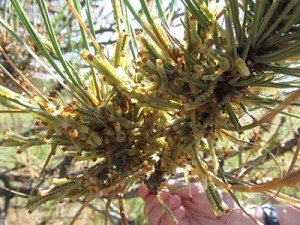
FRANKTOWN, Colo. – A pine sawfly outbreak in Elbert County that received significant media attention in 2014 is predicted to again result in heavy needle loss in some local pine stands this summer, based on a report released today by the Colorado State Forest Service. The report indicates that while many ponderosa pine stands in the county will suffer little to no sawfly defoliation this year, others likely will suffer another season of moderate to heavy defoliation.
The CSFS, in partnership with Fort Collins-based Forest Health Management International, conducted an egg survey last fall and again in April to predict the potential for defoliation by the pine sawfly this season, based on counts of egg-infested needles. The survey will help foresters better predict future sawfly outbreaks, and also can help local landowners determine if they should consider measures to mitigate potential tree damage in 2015. Chemical insecticides are effective at reducing sawfly populations in June, when the eggs begin to hatch.
“This is the first attempt to predict future defoliation by this sawfly species in Colorado,” said Dan West, CSFS forest entomologist. “We hope to ultimately generate a model to better predict future outbreaks here in our state.”
The pine sawfly, a native insect, has been relatively abundant in the ponderosa pine forests of Elbert and El Paso counties for a number of years. In July 2014, however, its populations reached epidemic levels in Elbert County and neighboring portions of El Paso County. Aerial surveys conducted by the CSFS and USDA Forest Service in August 2014 indicated that approximately 7,400 acres had been impacted by the insect in Elbert, El Paso and Douglas counties.
Pine sawfly larvae, which typically hatch in mid to late June to feed on pine needles through the summer, later pupate in the upper soil layer of the forest floor, then emerge as wasps in the fall and lay eggs that overwinter on pine needles. Natural control agents, including diseases, parasitic wasps and other predators, can combat sawflies.
West says that he and other entomologists aren’t certain what environmental factors caused the spike in the sawfly population in 2014.
To view the full sawfly report, visit the CSFS Franktown District.

